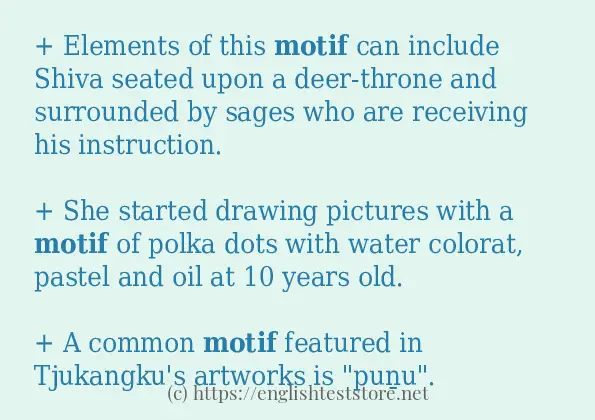How to use in-sentence of “motif”:
+ Elements of this motif can include Shiva seated upon a deer-throne and surrounded by sages who are receiving his instruction.
+ She started drawing pictures with a motif of polka dots with water colorat, pastel and oil at 10 years old.
+ A common motif featured in Tjukangku’s artworks is “puṉu”.
+ The most obvious motif seen in them is the circles and lines, which depict dreaming tracks.
+ The first known appearance of the ouroboros motif is in KV62, the tomb of Tutankhamun, in the 14th century BC.
+ Three bars before the end we hear the BACH motif in the left hand.

Example sentences of “motif”:
+ During World War II, the BBC used the four-note motif to introduce its radio news broadcasts because "short-short-short-long" spells the letter "V" in Morse code.
+ It is based on the Motif Motif widget toolkit.
+ The ending also repeats the arpeggiated guitar motif from the end of that song, similar to the figure featured in the George Harrison written songs "Here Comes the Sun" and "Badge.
+ During World War II, the BBC used the four-note motif to introduce its radio news broadcasts because “short-short-short-long” spells the letter “V” in Morse code.
+ It is based on the Motif Motif widget toolkit.
+ The ending also repeats the arpeggiated guitar motif from the end of that song, similar to the figure featured in the George Harrison written songs “Here Comes the Sun” and “Badge.
+ This is a curving decorative motif widely used in Azerbaijani art.
+ This Ancient Roman motif described by the architectural writer Sebastiano Serlio in “Tutte l’opere d’architettura et prospetiva” is often referred to as the “Palladian Arch”.
+ Peanut’s humor is not based on a particular motif or stereotype, as those of the other characters, and has been described as “the bad kid”.
+ The sandal also bears the motif of a Heraclean knot.
+ In art, a motif is a repeated pattern, image, or theme.
+ In addition to this, it uses the motif of SK group’s Happy Wings so that the Jeju residents would become united through the soccer.
+ Stately floral designs featuring a pomegranate or artichoke motif had reached Europe from China in the previous century and became a dominant design in the Ottoman silk-producing cities of Istanbul and Bursa, and spread to silk weavers in Florence, Genoa, Venice, Valencia and Seville in this period.
